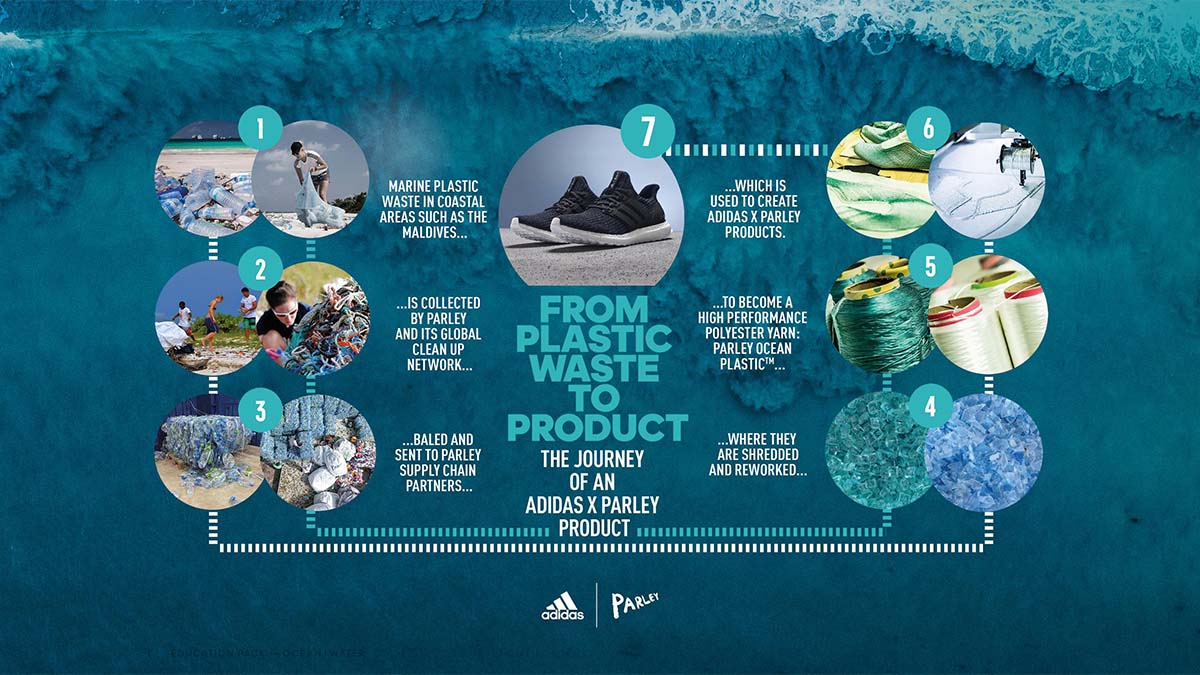Focus on ocean plastic pollution got all-star effort from NHL, Adidas

The uniforms worn by players during the 2019 National Hockey League All-Star Game in San Jose were designed in part to highlight the colors of the game — the black of the puck and the white of a fresh sheet of ice.

While the game is played on a frozen sheet of ice, the sweaters or jerseys worn by the league’s top players that weekend were created from debris gathered from our oceans.
The uniforms were made from upcycled marine plastic debris by adidas, which has been a league partner since 2017. Upcycling is the process of transforming waste materials, such as plastic bottles, into new products.
An estimated 8 million metric tons of plastic enter our oceans every year. The league, which has promoted environmental initiatives such as its NHL Green campaign, partnered with adidas in large part because it felt the entities could elevate eco-friendly awareness generally while promoting it through specific projects such as the all-star sweaters.
“When the NHL selected our new uniform partner, some of the key criteria was whether we had the right brand partner and whether we could tap into what I would say is their global innovation pipeline,” said Brian Jennings, the NHL’s chief branding partner and executive vice president. “Each jersey was crafted to be a symbol of change in the movement to protect the oceans.”
As part of its efforts to address global concerns, adidas created symbols of change through its Adizero Authentic Pro x Parley jersey. Parley is an environmental organization that addresses threats to the ocean and is involved in numerous global projects such as cleanup day in the Maldives.
Marine plastic waste is reworked into fibers used to create a durable, comfortable fabric. The environmental and athletic concerns were woven into a single product.
“Whether it’s sustainability- or environmental-related programs, diversity, inclusion and equality in sport, or simply providing access to the game, we connect this to our umbrella philosophy, and that is through sport we have the power to change lives,” said Dan Near, senior director of adidas hockey. “Additionally, we seek to inspire through our athletes, our products, our style and in communities. The NHL has embraced this and has encouraged us to utilize the sport of hockey as a springboard for these efforts.”
The average person might wonder how top-of-the-line jerseys worn by the game’s best during a league showcase event could have the look and feel of a traditional sweater when they are made from marine waste.
In order to ensure that was the case, Jennings noted the project went through various iterations with plenty of testing and learning along the way. During the process, there was never a question whether the league and adidas could pull it off.
“There is no doubt we felt the design was strong,” he said. “It still looked like a hockey jersey and we knew the best players in the NHL would be wearing this. What ultimately got us equally excited was the reaction the players had to it across the board. When the (players) heard about the story (of how the jerseys were created), they embraced it in a big way and in many ways helped make it the success that it was.”

Who better to endorse a sweater than the player regarded as the face of the NHL, Pittsburgh’s Sidney Crosby? The three-time Stanley Cup winner and two-time league MVP visited adidas’ North American headquarters in Portland, Oregon. last summer for a first-hand look.
“In addition to being one of the greatest players ever to play the game, Sidney is meticulous about his on-ice setup and wanted to know every detail about the Parley initiative,” said Near, who gladly noted Crosby was named MVP of the all-star game.
The sweaters, which were made available through adidas and NHL online outlets as well as team stores for $200, featured each player’s team logo instead of an all-star crest. They are not the only example of a product adidas has marketed with the environment in mind.
Near noted that in 2017 adidas and Parley prevented 11 million water bottles “from reaching our oceans” through the manufacture of other athletic products.
The company created and sold more than one million pairs of adidas x Parley running shoes that year and five million in 2018. The company projects 11 million sales in 2019. Near added that at some point this year consumers could see adidas x Parley products through a partnership with the NCAA.
Near indicated the company has had discussions about developing other hockey-related products.
“We’ve spoken to a lot of other areas and departments about the potential for utilizing Parley repurposed and upcycled materials and yarns in other products to help create awareness and embed it into the mindset of the sport and the culture,” he said. “Whether that’s the monofilament above the Plexiglas (atop the dasher boards that encircle the ice surface), the actual goals, or broader approaches such as championing plastic waste reduction in sports arenas.”
Given the sweaters’ successful debut and global manufacturing effort, other leagues have expressed interest in the product.
“It’s rare that we meet with a club, league or partner and don’t get asked ‘What’s next with adidas Hockey x Parley?’” Near said. “Though we’re not prepared to announce future rollouts at this time, the appeal and desire to extend our environmentally conscience Parley products in hockey is undeniable.”
So is the strength of the partnership between the NHL and adidas, especially when it comes to promoting sustainable practices.
Tom Layberger has spent more than 25 years as a writer, editor and web producer for various media outlets. Tom, who resides in Tampa, is a graduate of the University of South Florida. Follow him on Twitter @TomLay810
Note: The Global Sport Institute is supported by a combination of institutional ASU funding and a significant philanthropic gift from Adidas. GlobalSport Matters is a publication in partnership between the Walter Cronkite School of Journalism and Mass Communication and the Global Sport Institute.
Related Articles
Ocean racers did more than compete, they tracked growing plastics problem

